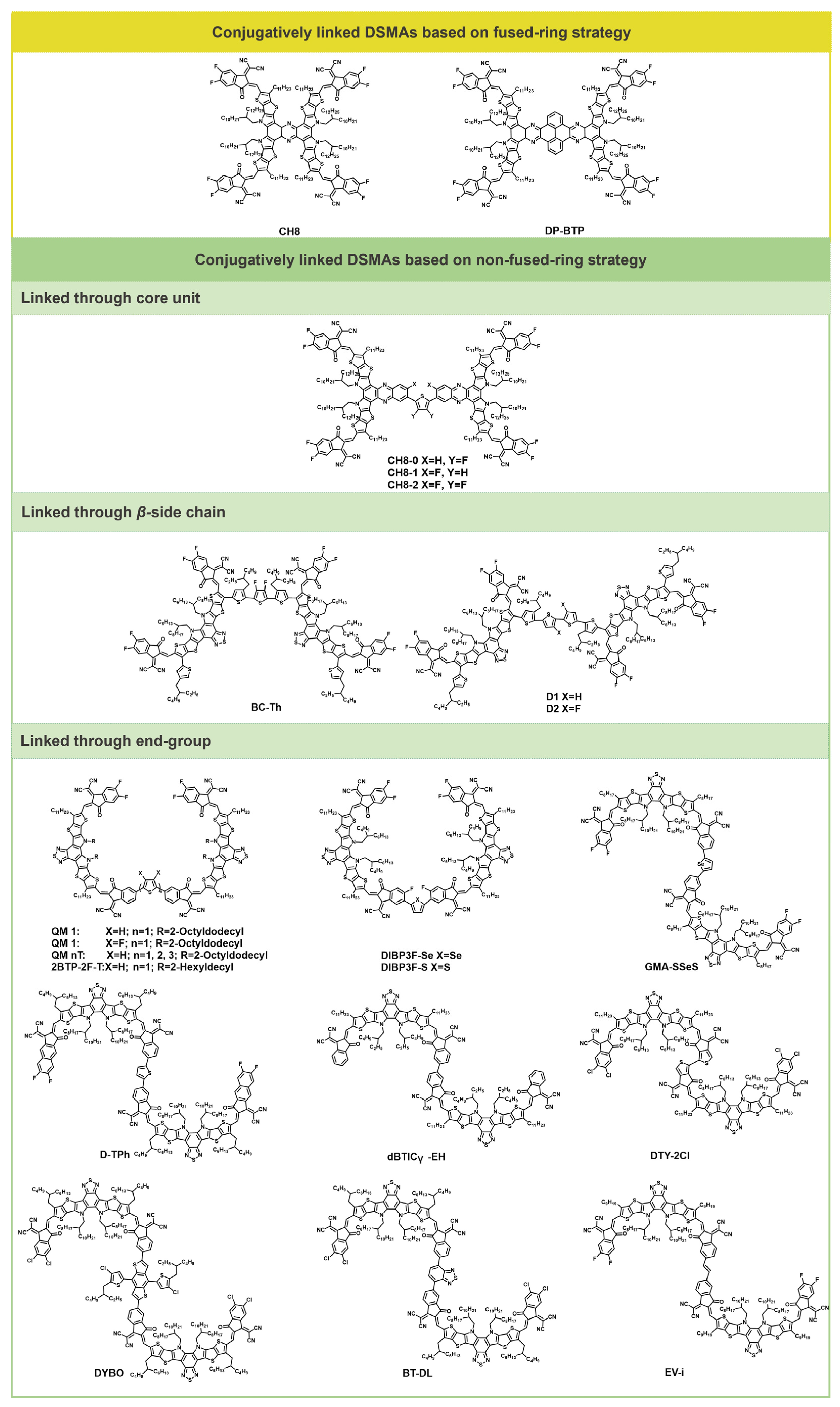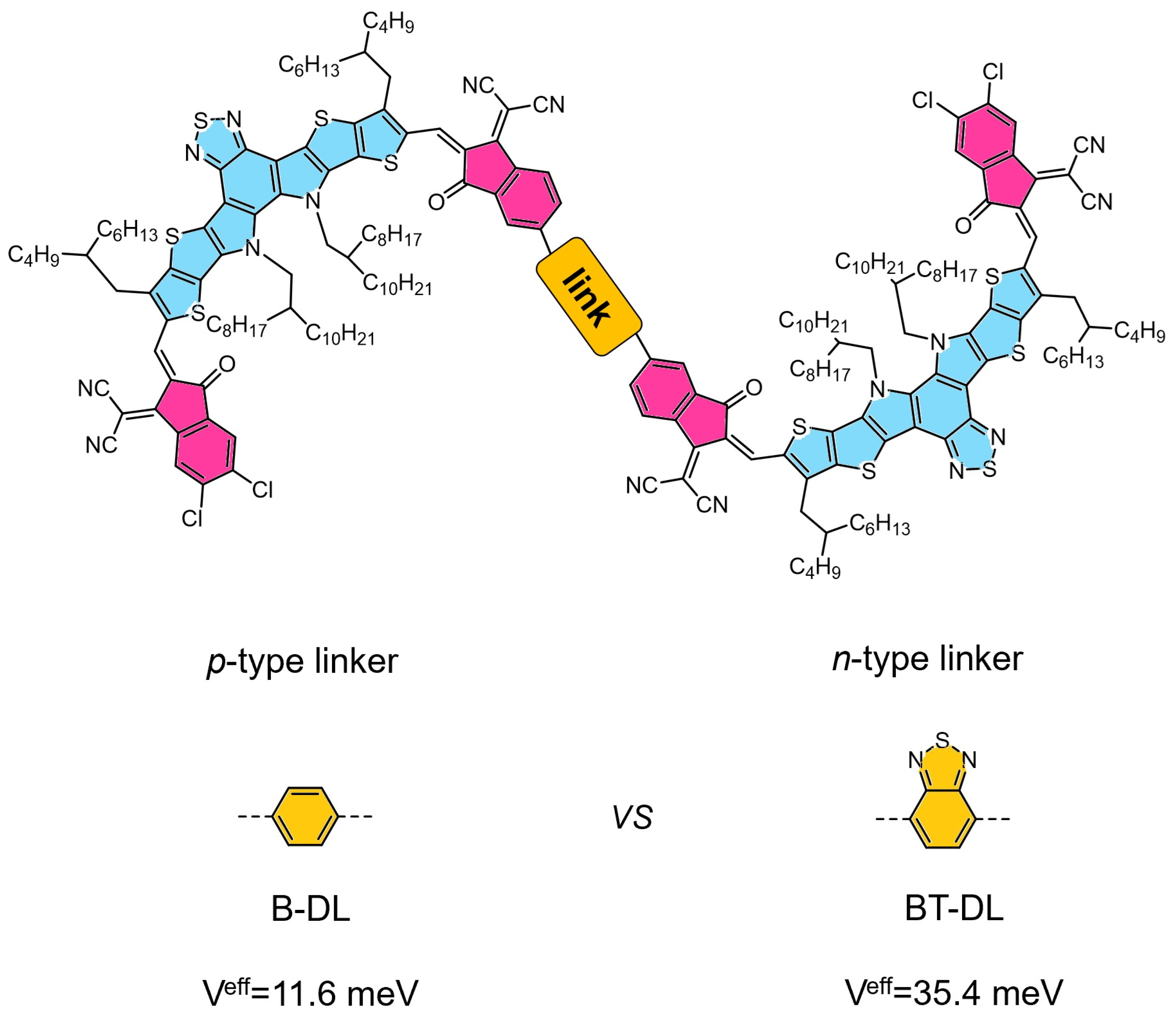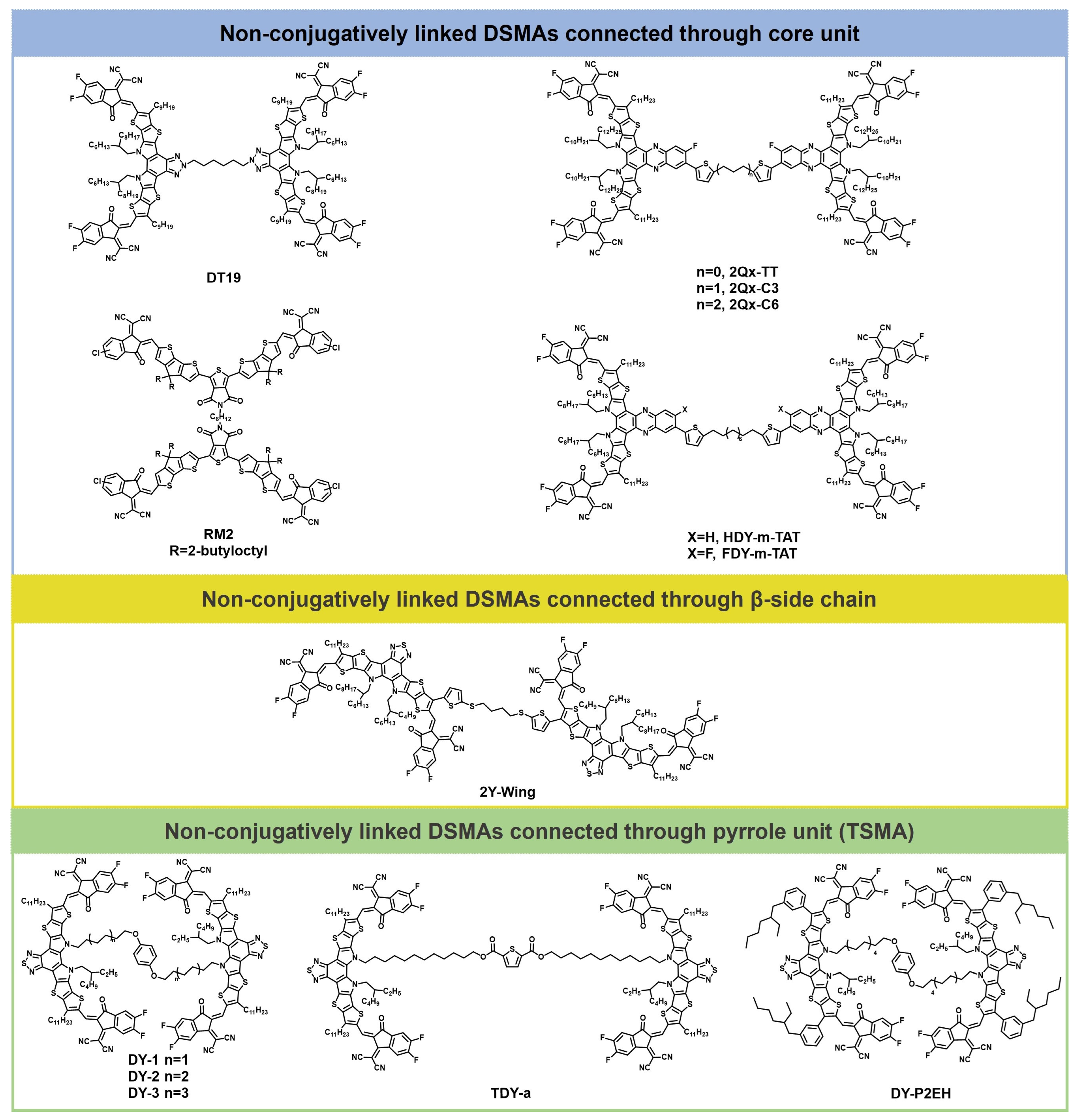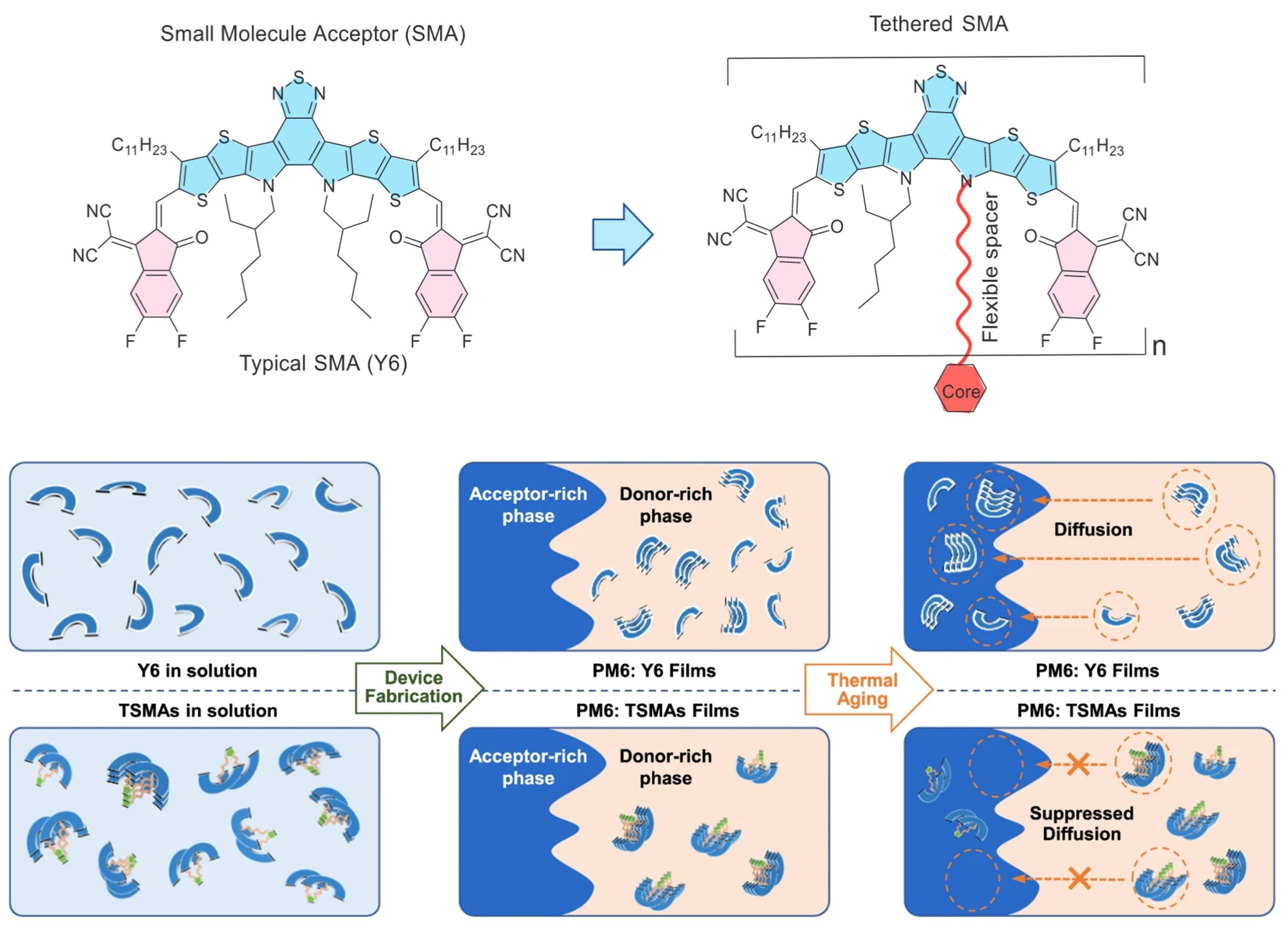Recent Progress in Dimerized Small-Molecular Acceptors for Organic Solar Cells
Abstract
1. Introduction
2. Conjugatively Linked DSMAs
2.1. Conjugatively Linked DSMAs Based on Fused-Ring Strategy
2.2. Conjugatively Linked DSMAs Based on Non-Fused-Ring Strategy
3. Non-Conjugatively Linked DSMAs
4. Conclusions and Outlook
Institutional Review Board Statement
Informed Consent Statement
Data Availability Statement
Acknowledgments
Conflicts of Interest
References
- Brabec, C.J. Organic photovoltaics: Technology and market. Sol. Energy Mater. Sol. Cells 2004, 83, 273–292. [Google Scholar] [CrossRef]
- Dou, L.; You, J.; Hong, Z.; Xu, Z.; Li, G.; Street, R.A.; Yang, Y. 25th anniversary article: A decade of organic/polymeric photovoltaic research. Adv. Mater. 2013, 25, 6642–6671. [Google Scholar] [CrossRef] [PubMed]
- Mazzio, K.A.; Luscombe, C.K. The future of organic photovoltaics. Chem. Soc. Rev. 2015, 44, 78–90. [Google Scholar] [CrossRef] [PubMed]
- Ameri, T.; Khoram, P.; Min, J.; Brabec, C.J. Organic ternary solar cells: A review. Adv. Mater. 2013, 25, 4245–4266. [Google Scholar] [CrossRef]
- An, Q.; Zhang, F.; Zhang, J.; Tang, W.; Deng, Z.; Hu, B. Versatile ternary organic solar cells: A critical review. Energy Environ. Sci. 2016, 9, 281–322. [Google Scholar] [CrossRef]
- Hoppe, H.; Sariciftci, N.S. Organic solar cells: An overview. J. Mater. Res. 2004, 19, 1924–1945. [Google Scholar] [CrossRef]
- Thompson, B.C.; Fréchet, J.M.J. Polymer–Fullerene composite solar cells. Angew. Chem. Int. Ed. 2008, 47, 58–77. [Google Scholar] [CrossRef]
- Butt, M.A. Thin-film coating methods: A successful marriage of high-quality and cost-effectiveness—A brief exploration. Coatings 2022, 12, 1115. [Google Scholar] [CrossRef]
- Wang, H.; Zeng, Z.; Xu, P.; Li, L.; Zeng, G.; Xiao, R.; Tang, Z.; Huang, D.; Tang, L.; Lai, C.; et al. Recent progress in covalent organic framework thin films: Fabrications, applications and perspectives. Chem. Soc. Rev. 2019, 48, 488–516. [Google Scholar] [CrossRef]
- Zhang, F.; Di, C.-a.; Berdunov, N.; Hu, Y.; Hu, Y.; Gao, X.; Meng, Q.; Sirringhaus, H.; Zhu, D. Ultrathin film organic transistors: Precise control of semiconductor thickness via spin-coating. Adv. Mater. 2013, 25, 1401–1407. [Google Scholar] [CrossRef]
- Todor-Boer, O.; Petrovai, I.; Tarcan, R.; David, L.; Astilean, S.; Botiz, I. Control of microstructure in polymer: Fullerene active films by convective self-assembly. Thin Solid Films 2020, 697, 137780. [Google Scholar] [CrossRef]
- Wu, Q.; Ding, S.; Sun, A.; Xia, Y. Recent progress on non-fullerene acceptor materials for organic solar cells. Mater. Today Chem. 2024, 41, 102290. [Google Scholar]
- Cui, Y.; Xu, Y.; Yao, H.; Bi, P.; Hong, L.; Zhang, J.; Zu, Y.; Zhang, T.; Qin, J.; Ren, J.; et al. Single-junction organic photovoltaic cell with 19% efficiency. Adv. Mater. 2021, 33, 2102420. [Google Scholar] [CrossRef] [PubMed]
- Li, C.; Zhou, J.; Song, J.; Xu, J.; Zhang, H.; Zhang, X.; Guo, J.; Zhu, L.; Wei, D.; Han, G.; et al. Non-fullerene acceptors with branched side chains and improved molecular packing to exceed 18% efficiency in organic solar cells. Nat. Energy 2021, 6, 605–613. [Google Scholar]
- Lin, Y.; Wang, J.; Zhang, Z.-G.; Bai, H.; Li, Y.; Zhu, D.; Zhan, X. An electron acceptor challenging fullerenes for efficient polymer solar cells. Adv. Mater. 2015, 27, 1170–1174. [Google Scholar]
- Yuan, J.; Zhang, Y.; Zhou, L.; Zhang, G.; Yip, H.-L.; Lau, T.-K.; Lu, X.; Zhu, C.; Peng, H.; Johnson, P.A.; et al. Single-junction organic solar cell with over 15% efficiency using fused-ring acceptor with electron-deficient core. Joule 2019, 3, 1140–1151. [Google Scholar]
- Sun, Y.; Wang, L.; Guo, C.; Xiao, J.; Liu, C.; Chen, C.; Xia, W.; Gan, Z.; Cheng, J.; Zhou, J.; et al. Π-extended nonfullerene acceptor for compressed molecular packing in organic solar cells to achieve over 20% efficiency. J. Am. Chem. Soc. 2024, 146, 12011–12019. [Google Scholar]
- Zheng, Z.; Wang, J.; Bi, P.; Ren, J.; Wang, Y.; Yang, Y.; Liu, X.; Zhang, S.; Hou, J. Tandem organic solar cell with 20.2% efficiency. Joule 2022, 6, 171–184. [Google Scholar] [CrossRef]
- Lai, H.; Lai, X.; Lang, Y.; Luo, Y.; Han, L.; Zhu, Y.; Xiong, S.; Shen, X.; Ding, Y.; Wu, J.; et al. Molecular skeletons modification induces distinctive aggregation behaviors and boosts the efficiency over 19% in organic solar cells. CCS Chem. 2024, 1–14. [Google Scholar] [CrossRef]
- Li, M.; Tian, L.; He, F. How can we improve the stability of organic solar cells from materials design to device engineering? Aggregate 2024, 5, e567. [Google Scholar] [CrossRef]
- Zhao, F.; Zhang, H.; Zhang, R.; Yuan, J.; He, D.; Zou, Y.; Gao, F. Emerging approaches in enhancing the efficiency and stability in non-fullerene organic solar cells. Adv. Energy Mater. 2020, 10, 2002746. [Google Scholar]
- Lee, J.-W.; Sun, C.; Phan, T.N.-L.; Lee, D.C.; Tan, Z.; Jeon, H.; Cho, S.; Kwon, S.-K.; Kim, Y.-H.; Kim, B.J. Trimerized small-molecule acceptors enable high-performance organic solar cells with high open-circuit voltage and prolonged life-time. Energy Environ. Sci. 2023, 16, 3339–3349. [Google Scholar] [CrossRef]
- Liang, Y.; Zhang, D.; Wu, Z.; Jia, T.; Lüer, L.; Tang, H.; Hong, L.; Zhang, J.; Zhang, K.; Brabec, C.J.; et al. Organic solar cells using oligomer acceptors for improved stability and efficiency. Nat. Energy 2022, 7, 1180–1190. [Google Scholar] [CrossRef]
- Zhang, Z.-G.; Li, Y. Polymerized small-molecule acceptors for high-performance all-polymer solar cells. Angew. Chem. Int. Ed. 2021, 60, 4422–4433. [Google Scholar] [CrossRef]
- Fan, Q.; An, Q.; Lin, Y.; Xia, Y.; Li, Q.; Zhang, M.; Su, W.; Peng, W.; Zhang, C.; Liu, F.; et al. Over 14% efficiency all-polymer solar cells enabled by a low bandgap polymer acceptor with low energy loss and efficient charge separation. Energy Environ. Sci. 2020, 13, 5017–5027. [Google Scholar] [CrossRef]
- Fan, Q.; Fu, H.; Bai, H.; Zhang, R.; Huang, K.; Zheng, Q.; Ma, W.; Jen, A.K.Y. Nir-absorbing polymer acceptor for efficient all-polymer solar cells with a record-high photocurrent of 26.5 ma cm−2. DeCarbon 2023, 2, 100024. [Google Scholar] [CrossRef]
- Wang, W.; Wu, Q.; Sun, R.; Guo, J.; Wu, Y.; Shi, M.; Yang, W.; Li, H.; Min, J. Controlling molecular mass of low-band-gap polymer acceptors for high-performance all-polymer solar cells. Joule 2020, 4, 1070–1086. [Google Scholar] [CrossRef]
- Chen, T.; Zheng, X.; Wang, D.; Zhu, Y.; Ouyang, Y.; Xue, J.; Wang, M.; Wang, S.; Ma, W.; Zhang, C.; et al. Delayed crystallization kinetics allowing high-efficiency all-polymer photovoltaics with superior upscaled manufacturing. Adv. Mater. 2024, 36, 2308061. [Google Scholar]
- Ma, R.; Fan, Q.; Dela Peña, T.A.; Wu, B.; Liu, H.; Wu, Q.; Wei, Q.; Wu, J.; Lu, X.; Li, M.; et al. Unveiling the morphological and physical mechanism of burn-in loss alleviation by ternary matrix toward stable and efficient all-polymer solar cells. Adv. Mater. 2023, 35, 2212275. [Google Scholar] [CrossRef]
- Qiu, D.; Zhang, H.; Tian, C.; Zhang, J.; Zhu, L.; Wei, Z.; Lu, K. Central core substitutions and film-formation process optimization enable approaching 19% efficiency all-polymer solar cells. Adv. Mater. 2023, 35, 2307398. [Google Scholar] [CrossRef]
- Wang, H.; Cao, C.; Chen, H.; Lai, H.; Ke, C.; Zhu, Y.; Li, H.; He, F. Oligomeric acceptor: A “two-in-one” strategy to bridge small molecules and polymers for stable solar devices. Angew. Chem. Int. Ed. 2022, 61, e202201844. [Google Scholar] [CrossRef]
- Chen, H.; Cao, X.; Xu, X.; Li, C.; Wan, X.; Yao, Z.; Chen, Y. A low reorganization energy and two-dimensional acceptor with four end units for organic solar cells with low eloss. Chin. J. Polym. Sci. 2022, 40, 921–927. [Google Scholar] [CrossRef]
- Liu, X.; Zhang, Z.; Wang, C.; Zhang, C.; Liang, S.; Fang, H.; Wang, B.; Tang, Z.; Xiao, C.; Li, W. A pyrene-fused dimerized acceptor for ternary organic solar cells with 19% efficiency and high thermal stability. Angew. Chem. Int. Ed. 2024, 63, e202316039. [Google Scholar] [CrossRef]
- Chen, H.; Zhang, Z.; Wang, P.; Zhang, Y.; Ma, K.; Lin, Y.; Duan, T.; He, T.; Ma, Z.; Long, G.; et al. 3d acceptors with multiple a–d–a architectures for highly efficient organic solar cells. Energy Environ. Sci. 2023, 16, 1773–1782. [Google Scholar] [CrossRef]
- Ma, K.; Liang, H.; Wang, Y.; He, T.; Duan, T.; Si, X.; Shi, W.; Long, G.; Cao, X.; Yao, Z.; et al. A case study of comparing two dimerized acceptor molecules built by different branch-connected and terminal-connected approaches. Sci. China Chem. 2024, 67, 1687–1696. [Google Scholar] [CrossRef]
- Wang, Y.; Jia, X.; Ma, K.; Zhao, W.; Liang, H.; Yao, Z.; Long, G.; Li, C.; Wan, X.; Chen, Y. Linker group fluorination boosts photovoltaic performance of branch-connected dimerized acceptors. Macromol. Rapid Commun. 2024, 46, 2400687. [Google Scholar] [CrossRef]
- Shen, X.; Lai, X.; Lai, H.; Wang, Y.; Li, H.; Ou, M.; He, F. Highly planar oligomeric acceptor enables efficiency over 18% with synergistically enhanced voc and light absorption. Adv. Funct. Mater. 2024, 34, 2404919. [Google Scholar] [CrossRef]
- Liu, W.; Yuan, J.; Zhu, C.; Wei, Q.; Liang, S.; Zhang, H.; Zheng, G.; Hu, Y.; Meng, L.; Gao, F.; et al. A-π-A structured non-fullerene acceptors for stable organic solar cells with efficiency over 17%. Sci. China Chem. 2022, 65, 1374–1382. [Google Scholar] [CrossRef]
- He, S.; Xiang, C.; Liu, W.; Liang, S.; Zhang, R.; Chen, W.; Zhao, B.; Yuan, J.; Zou, Y. A–π–A type quasi-macromolecular acceptors with molecular conjugation length control strategy for high-performance organic solar cells. J. Mater. Chem. A 2024, 12, 31581–31588. [Google Scholar] [CrossRef]
- Zhang, L.; Zhang, Z.; Deng, D.; Zhou, H.; Zhang, J.; Wei, Z. “N-π-N” type oligomeric acceptor achieves an opv efficiency of 18.19% with low energy loss and excellent stability. Adv. Mater. 2022, 9, 2202513. [Google Scholar] [CrossRef]
- Wu, J.; Ling, Z.; Franco, L.R.; Jeong, S.Y.; Genene, Z.; Mena, J.; Chen, S.; Chen, C.; Araujo, C.M.; Marchiori, C.F.N.; et al. On the conformation of dimeric acceptors and their polymer solar cells with efficiency over 18 %. Angew. Chem. Int. Ed. 2023, 62, e202302888. [Google Scholar]
- Shi, J.; Ding, P.; Zhu, J.; Chen, Z.; Gao, S.; Yu, X.; Liao, X.; Liu, Q.; Ge, Z. Well-regulated structure-featuring giant-molecule acceptors enable long-term stability and high-performance binary organic solar cells. Energy Environ. Sci. 2024, 17, 9144–9153. [Google Scholar]
- Sun, C.; Lee, J.-W.; Lee, C.; Lee, D.; Cho, S.; Kwon, S.-K.; Kim, B.J.; Kim, Y.-H. Dimerized small-molecule acceptors enable efficient and stable organic solar cells. Joule 2023, 7, 416–430. [Google Scholar]
- Zhuo, H.; Li, X.; Zhang, J.; Qin, S.; Guo, J.; Zhou, R.; Jiang, X.; Wu, X.; Chen, Z.; Li, J.; et al. Giant molecule acceptor enables highly efficient organic solar cells processed using non-halogenated solvent. Angew. Chem. Int. Ed. 2023, 62, e202303551. [Google Scholar]
- Li, Y.; Ge, Z.; Mei, L.; Ma, H.; Chen, Y.; Wang, X.; Yu, J.; Lu, G.; Yang, R.; Chen, X.-K.; et al. Isomeric dimer acceptors for stable organic solar cells with over 19 % efficiency. Angew. Chem. Int. Ed. 2024, 63, e202411044. [Google Scholar] [CrossRef]
- Fu, H.; Wang, Q.; Chen, Q.; Zhang, Y.; Meng, S.; Xue, L.; Zhang, C.; Yi, Y.; Zhang, Z.-G. Dimeric giant molecule acceptors featuring n-type linker: Enhancing intramolecular coupling for high-performance polymer solar cells. Angew. Chem. Int. Ed. 2024, 63, e202403005. [Google Scholar]
- Niu, J.; Sun, M.; Bi, F.; Lin, G.; Wen, S.; Sun, C.; Sun, M.; Bao, X. Dimerized small-molecule acceptors with electron withdrawing linker for efficient organic solar cells. Chem. Eng. J. 2025, 507, 160416. [Google Scholar]
- Ling, Z.; Wu, J.; Jurado, J.P.; Petoukhoff, C.E.; Jeong, S.Y.; Naphade, D.; Babics, M.; Chang, X.; Faber, H.; Doukas, S.; et al. 20.5% efficient ternary organic photovoltaics using an asymmetric small-molecular acceptor to manipulate intermolecular packing and reduce energy losses. Mater. Sci. Eng. R Rep. 2025, 163, 100922. [Google Scholar] [CrossRef]
- Li, R.; Hu, Y.; Xu, Y.; Wang, C.; Li, X.; Liang, S.; Liu, B.; Li, W. Dimerized nonfused electron acceptor based on a thieno[3,4-c]pyrrole-4,6-dione core for organic solar cells. ACS Appl. Mater. Interfaces 2024, 16, 22256–22264. [Google Scholar]
- Wan, J.; Wang, T.; Sun, R.; Wu, X.; Wang, S.; Zhang, M.; Min, J. Enabling highly efficient and thermal-stable polymer solar cells through semi-alloy acceptors composed of a hinge-like dimer: A versatile doping protocol. Adv. Mater. 2023, 35, 2302592. [Google Scholar]
- You, S.; Zhang, Y.; Huang, B.; Jeong, S.Y.; Shuai, X.; Huang, S.; Woo, H.Y.; Wu, F.; Chen, L. Linkage regulation of back-to-back connected dimers as guest acceptors enables organic solar cells with excellent efficiency, stability and flexibility. Adv. Funct. Mater. 2024, 35, 2414803. [Google Scholar]
- Ding, Y.; Memon, W.A.; Zhang, D.; Zhu, Y.; Xiong, S.; Wang, Z.; Liu, J.; Li, H.; Lai, H.; Shao, M.; et al. Dimerized acceptors with conjugate-break linker enable highly efficient and mechanically robust organic solar cells. Angew. Chem. Int. Ed. 2024, 63, e202403139. [Google Scholar] [CrossRef] [PubMed]
- Li, S.; Zhang, R.; Zhang, M.; Yao, J.; Peng, Z.; Chen, Q.; Zhang, C.; Chang, B.; Bai, Y.; Fu, H.; et al. Tethered small-molecule acceptors simultaneously enhance the efficiency and stability of polymer solar cells. Adv. Mater. 2023, 35, 2206563. [Google Scholar]
- Zhang, M.; Chang, B.; Zhang, R.; Li, S.; Liu, X.; Zeng, L.; Chen, Q.; Wang, L.; Yang, L.; Wang, H.; et al. Tethered small-molecule acceptor refines hierarchical morphology in ternary polymer solar cells: Enhanced stability and 19% efficiency. Adv. Mater. 2024, 36, 2308606. [Google Scholar]
- Bai, Y.; Zhang, Z.; Zhou, Q.; Geng, H.; Chen, Q.; Kim, S.; Zhang, R.; Zhang, C.; Chang, B.; Li, S.; et al. Geometry design of tethered small-molecule acceptor enables highly stable and efficient polymer solar cells. Nat. Commun. 2023, 14, 2926. [Google Scholar]
- Yi, F.; Xiao, M.; Meng, Y.; Bai, H.; Su, W.; Gao, W.; Yao, Z.-F.; Qi, G.; Liang, Z.; Jin, C.; et al. Non-fully conjugated dimerized giant acceptors with different alkyl-linked sites for stable and 19.13% efficiency organic solar cells. Angew. Chem. Int. Ed. 2024, 63, e202319295. [Google Scholar]




| Active Layer | Voc [V] | Jsc [mA cm−2] | FF [%] | PCE [%] | Ref. |
|---|---|---|---|---|---|
| PM6: CH8 | 0.889 | 19.70 | 53.50 | 9.37 | [32] |
| D18: DP-BTP | 0.960 | 22.73 | 69.10 | 15.08 | [33] |
| PM6: CH8-1 | 0.923 | 24.89 | 74.20 | 17.05 | [34] |
| D18: BC-Th | 0.893 | 24.67 | 79.13 | 17.43 | [35] |
| PM6: D2 | 0.876 | 24.33 | 78.17 | 16.66 | [36] |
| PBQx-H-TF: dBTICγ-EH | 0.910 | 23.41 | 75.49 | 16.06 | [31] |
| D18: DTY-2Cl | 0.913 | 26.2 | 75.46 | 18.06 | [37] |
| PM6: QM1 | 0.910 | 25.23 | 74.01 | 17.05 | [38] |
| PM6: QM-2T | 0.940 | 25.75 | 73.80 | 17.86 | [39] |
| PM6: 2BTP-2F-T | 0.911 | 25.50 | 78.28 | 18.19 | [40] |
| PM6: DIBP3F-Se | 0.917 | 25.92 | 76.10 | 18.09 | [41] |
| PM6: GMA-SSeS | 0.917 | 27.38 | 77.12 | 19.37 | [42] |
| PM6: DYBO | 0.968 | 24.62 | 75.80 | 18.08 | [43] |
| PM6: EV-I | 0.897 | 26.60 | 76.56 | 18.27 | [44] |
| PM6: D-TPh | 0.946 | 25.59 | 78.7 | 19.05 | [45] |
| PM6: BT-DL | 0.94 | 25.523 | 77.08 | 18.49 | [46] |
| DY-IDG | 0.909 | 21.78 | 70.78 | 14.01 | [47] |
| Active Layer | Voc [V] | Jsc [mA cm−2] | FF [%] | PCE [%] | Ref. |
|---|---|---|---|---|---|
| PM6: RM2 | 0.856 | 18.33 | 70.00 | 11.05 | [49] |
| PM1: L8-BO: DT19 | 0.899 | 27.80 | 73.80 | 18.40 | [50] |
| PM6: L8-BO: 2Qx-C3 | 0.898 | 26.45 | 80.10 | 19.03 | [51] |
| PM6: FDY-m-TAT | 0.911 | 26.47 | 74.70 | 18.07 | [52] |
| PM6: DY2 | 0.870 | 26.60 | 76.85 | 17.85 | [53] |
| PM6: DY-P2EH | 0.905 | 24.03 | 78.58 | 17.09 | [54] |
| PM6: TDY-α | 0.864 | 26.90 | 78.00 | 18.10 | [55] |
| D18: 2Y-wing | 0.850 | 27.66 | 75.40 | 17.73 | [56] |
Disclaimer/Publisher’s Note: The statements, opinions and data contained in all publications are solely those of the individual author(s) and contributor(s) and not of MDPI and/or the editor(s). MDPI and/or the editor(s) disclaim responsibility for any injury to people or property resulting from any ideas, methods, instructions or products referred to in the content. |
© 2025 by the authors. Licensee MDPI, Basel, Switzerland. This article is an open access article distributed under the terms and conditions of the Creative Commons Attribution (CC BY) license (https://creativecommons.org/licenses/by/4.0/).
Share and Cite
Tang, X.; Zhang, Y.; Zhang, H.-L. Recent Progress in Dimerized Small-Molecular Acceptors for Organic Solar Cells. Molecules 2025, 30, 1630. https://doi.org/10.3390/molecules30071630
Tang X, Zhang Y, Zhang H-L. Recent Progress in Dimerized Small-Molecular Acceptors for Organic Solar Cells. Molecules. 2025; 30(7):1630. https://doi.org/10.3390/molecules30071630
Chicago/Turabian StyleTang, Xin, Yamin Zhang, and Hao-Li Zhang. 2025. "Recent Progress in Dimerized Small-Molecular Acceptors for Organic Solar Cells" Molecules 30, no. 7: 1630. https://doi.org/10.3390/molecules30071630
APA StyleTang, X., Zhang, Y., & Zhang, H.-L. (2025). Recent Progress in Dimerized Small-Molecular Acceptors for Organic Solar Cells. Molecules, 30(7), 1630. https://doi.org/10.3390/molecules30071630






